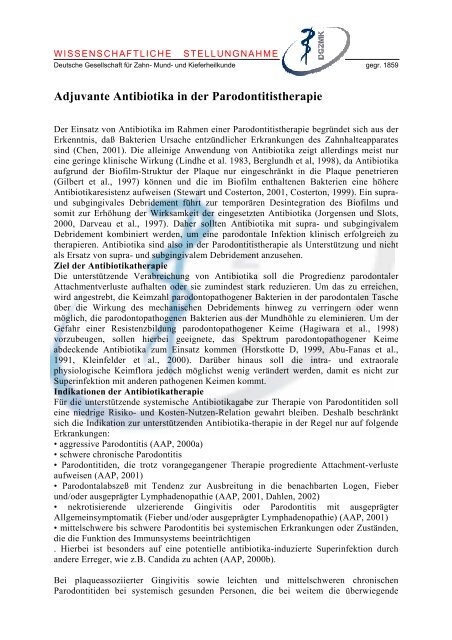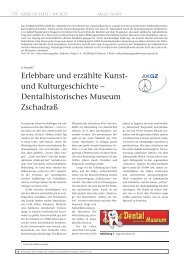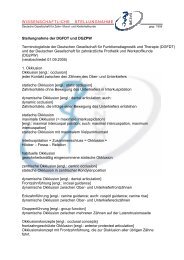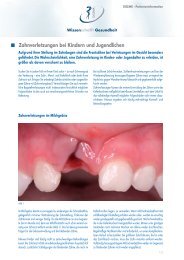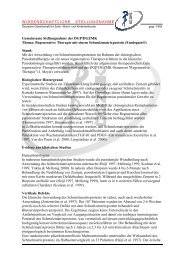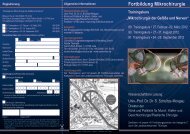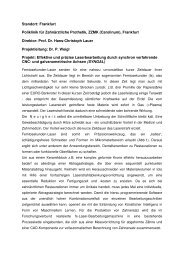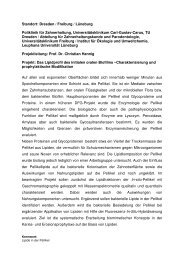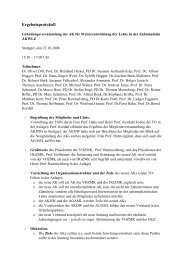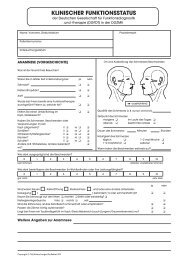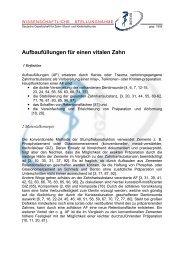Adjuvante Antibiotika in der Parodontitistherapie - Deutsche ...
Adjuvante Antibiotika in der Parodontitistherapie - Deutsche ...
Adjuvante Antibiotika in der Parodontitistherapie - Deutsche ...
Erfolgreiche ePaper selbst erstellen
Machen Sie aus Ihren PDF Publikationen ein blätterbares Flipbook mit unserer einzigartigen Google optimierten e-Paper Software.
WISSENSCHAFTLICHE STELLUNGNAHME<br />
<strong>Deutsche</strong> Gesellschaft für Zahn- Mund- und Kieferheilkunde gegr. 1859<br />
<strong>Adjuvante</strong> <strong>Antibiotika</strong> <strong>in</strong> <strong>der</strong> <strong>Parodontitistherapie</strong><br />
Der E<strong>in</strong>satz von <strong>Antibiotika</strong> im Rahmen e<strong>in</strong>er <strong>Parodontitistherapie</strong> begründet sich aus <strong>der</strong><br />
Erkenntnis, daß Bakterien Ursache entzündlicher Erkrankungen des Zahnhalteapparates<br />
s<strong>in</strong>d (Chen, 2001). Die alle<strong>in</strong>ige Anwendung von <strong>Antibiotika</strong> zeigt allerd<strong>in</strong>gs meist nur<br />
e<strong>in</strong>e ger<strong>in</strong>ge kl<strong>in</strong>ische Wirkung (L<strong>in</strong>dhe et al. 1983, Berglundh et al, 1998), da <strong>Antibiotika</strong><br />
aufgrund <strong>der</strong> Biofilm-Struktur <strong>der</strong> Plaque nur e<strong>in</strong>geschränkt <strong>in</strong> die Plaque penetrieren<br />
(Gilbert et al., 1997) können und die im Biofilm enthaltenen Bakterien e<strong>in</strong>e höhere<br />
<strong>Antibiotika</strong>resistenz aufweisen (Stewart und Costerton, 2001, Costerton, 1999). E<strong>in</strong> supra-<br />
und subg<strong>in</strong>givales Debridement führt zur temporären Des<strong>in</strong>tegration des Biofilms und<br />
somit zur Erhöhung <strong>der</strong> Wirksamkeit <strong>der</strong> e<strong>in</strong>gesetzten <strong>Antibiotika</strong> (Jorgensen und Slots,<br />
2000, Darveau et al., 1997). Daher sollten <strong>Antibiotika</strong> mit supra- und subg<strong>in</strong>givalem<br />
Debridement komb<strong>in</strong>iert werden, um e<strong>in</strong>e parodontale Infektion kl<strong>in</strong>isch erfolgreich zu<br />
therapieren. <strong>Antibiotika</strong> s<strong>in</strong>d also <strong>in</strong> <strong>der</strong> <strong>Parodontitistherapie</strong> als Unterstützung und nicht<br />
als Ersatz von supra- und subg<strong>in</strong>givalem Debridement anzusehen.<br />
Ziel <strong>der</strong> <strong>Antibiotika</strong>therapie<br />
Die unterstützende Verabreichung von <strong>Antibiotika</strong> soll die Progredienz parodontaler<br />
Attachmentverluste aufhalten o<strong>der</strong> sie zum<strong>in</strong>dest stark reduzieren. Um das zu erreichen,<br />
wird angestrebt, die Keimzahl parodontopathogener Bakterien <strong>in</strong> <strong>der</strong> parodontalen Tasche<br />
über die Wirkung des mechanischen Debridements h<strong>in</strong>weg zu verr<strong>in</strong>gern o<strong>der</strong> wenn<br />
möglich, die parodontopathogenen Bakterien aus <strong>der</strong> Mundhöhle zu elem<strong>in</strong>ieren. Um <strong>der</strong><br />
Gefahr e<strong>in</strong>er Resistenzbildung parodontopathogener Keime (Hagiwara et al., 1998)<br />
vorzubeugen, sollen hierbei geeignete, das Spektrum parodontopathogener Keime<br />
abdeckende <strong>Antibiotika</strong> zum E<strong>in</strong>satz kommen (Horstkotte D, 1999, Abu-Fanas et al.,<br />
1991, Kle<strong>in</strong>fel<strong>der</strong> et al., 2000). Darüber h<strong>in</strong>aus soll die <strong>in</strong>tra- und extraorale<br />
physiologische Keimflora jedoch möglichst wenig verän<strong>der</strong>t werden, damit es nicht zur<br />
Super<strong>in</strong>fektion mit an<strong>der</strong>en pathogenen Keimen kommt.<br />
Indikationen <strong>der</strong> <strong>Antibiotika</strong>therapie<br />
Für die unterstützende systemische <strong>Antibiotika</strong>gabe zur Therapie von Parodontitiden soll<br />
e<strong>in</strong>e niedrige Risiko- und Kosten-Nutzen-Relation gewahrt bleiben. Deshalb beschränkt<br />
sich die Indikation zur unterstützenden <strong>Antibiotika</strong>-therapie <strong>in</strong> <strong>der</strong> Regel nur auf folgende<br />
Erkrankungen:<br />
• aggressive Parodontitis (AAP, 2000a)<br />
• schwere chronische Parodontitis<br />
• Parodontitiden, die trotz vorangegangener Therapie progrediente Attachment-verluste<br />
aufweisen (AAP, 2001)<br />
• Parodontalabszeß mit Tendenz zur Ausbreitung <strong>in</strong> die benachbarten Logen, Fieber<br />
und/o<strong>der</strong> ausgeprägter Lymphadenopathie (AAP, 2001, Dahlen, 2002)<br />
• nekrotisierende ulzerierende G<strong>in</strong>givitis o<strong>der</strong> Parodontitis mit ausgeprägter<br />
Allgeme<strong>in</strong>symptomatik (Fieber und/o<strong>der</strong> ausgeprägter Lymphadenopathie) (AAP, 2001)<br />
• mittelschwere bis schwere Parodontitis bei systemischen Erkrankungen o<strong>der</strong> Zuständen,<br />
die die Funktion des Immunsystems bee<strong>in</strong>trächtigen<br />
. Hierbei ist beson<strong>der</strong>s auf e<strong>in</strong>e potentielle antibiotika-<strong>in</strong>duzierte Super<strong>in</strong>fektion durch<br />
an<strong>der</strong>e Erreger, wie z.B. Candida zu achten (AAP, 2000b).<br />
Bei plaqueassoziierter G<strong>in</strong>givitis sowie leichten und mittelschweren chronischen<br />
Parodontitiden bei systemisch gesunden Personen, die bei weitem die überwiegende
WISSENSCHAFTLICHE STELLUNGNAHME<br />
<strong>Deutsche</strong> Gesellschaft für Zahn- Mund- und Kieferheilkunde gegr. 1859<br />
Mehrzahl <strong>der</strong> Parodontalerkrankungen darstellen, hat e<strong>in</strong>e unterstützende antibiotische<br />
Behandlung gegenüber <strong>der</strong> alle<strong>in</strong>igen mechanischen <strong>Parodontitistherapie</strong> (supra- und<br />
subg<strong>in</strong>givales Debridement und eventuell Lappenoperation) meist ke<strong>in</strong>en zusätzlichen<br />
Nutzen (Ciancio, 2002, Slots und Jorgensen, 2002, Slots und Rams, 1990)<br />
Ob e<strong>in</strong>e <strong>Antibiotika</strong>therapie das Behandlungsergebnis bei <strong>der</strong> regenerativen<br />
Parodontalchirurgie (gesteuerte Geweberegeneration, autogene o<strong>der</strong> allogene<br />
Knochenimplantate) o<strong>der</strong> bei aktiven Rauchern verbessert, wird zur Zeit noch kontrovers<br />
diskutiert (Zucchelli et al., 1999, Mombelli et al., 1996, M<strong>in</strong>abe et al., 2000, Sculean et<br />
al., 2001). Für die Indikation e<strong>in</strong>er prophylaktischen <strong>Antibiotika</strong>gabe bei systemischen<br />
Erkrankungen, wie z.B. bei erhöhtem Endokarditisrisiko, wird auf die entsprechende<br />
DGZMK-Stellungnahme verwiesen (Horstkotte D, 1999)<br />
Zeitpunkt <strong>der</strong> <strong>Antibiotika</strong>therapie<br />
Um e<strong>in</strong>e möglichst effiziente Wirkung zu erreichen sollen die <strong>Antibiotika</strong> nach<br />
Des<strong>in</strong>tegration des Biofilms, d.h. direkt nach Abschluss des supra- und subg<strong>in</strong>givalen<br />
Debridements verabreicht werden (Jousimies-Somer et al., 1988).<br />
Auswahl <strong>der</strong> <strong>Antibiotika</strong><br />
Das Vorkommen parodontopathogener Bakterien ist bei Patienten mit Parodontitis<br />
<strong>in</strong>dividuell unterschiedlich (Paster et al., 2001) und die Wirksamkeit von <strong>Antibiotika</strong> auf<br />
e<strong>in</strong>ige Bakteriengruppen e<strong>in</strong>geschränkt.<br />
Deshalb soll zur Auswahl e<strong>in</strong>es geeigneten Antibiotikums die vorliegende parodontale<br />
Infektion durch e<strong>in</strong>e mikrobiologische Analyse <strong>der</strong> subg<strong>in</strong>givalen Plaque bestimmt<br />
werden (Slots und Jorgensen, 2002). Der Nachweis <strong>der</strong> bisher bekannten, eng mit <strong>der</strong><br />
Ätiologie <strong>der</strong> Parodontitiden assoziierten Bakterien (Act<strong>in</strong>obacillus<br />
act<strong>in</strong>omycetemcomitans, Porphyromonas g<strong>in</strong>givalis, Tanerella forsythensis [bisher:<br />
Bacteroides forsythus], Eikenella corrodens, Prevotella <strong>in</strong>termedia, Prevotella nigrescens<br />
und Treponema denticola) ist hierfür <strong>in</strong> <strong>der</strong> Regel ausreichend. Der parodontalen<br />
Infektion entsprechend, werden das Antibiotikum o<strong>der</strong> die <strong>Antibiotika</strong>komb<strong>in</strong>ation<br />
ausgewählt, für die gute antimikrobielle und kl<strong>in</strong>ische Wirkungen beschrieben wurden.<br />
Bei den Fällen, <strong>in</strong> denen das nicht e<strong>in</strong>deutig möglich ist, müssen weitere kl<strong>in</strong>ische Studien<br />
zur Klärung beitragen.<br />
Bei ungesicherter kl<strong>in</strong>ischer Datenlage soll aber zum<strong>in</strong>dest denjenigen <strong>Antibiotika</strong> <strong>der</strong><br />
Vorzug gegeben werden, für die bei systemischer Applikation Wirkstoffkonzentrationen<br />
im G<strong>in</strong>givalsulkus beschrieben wurde, die höher s<strong>in</strong>d als die <strong>in</strong> vitro ermittelten<br />
m<strong>in</strong>imalen Hemmkonzentrationen (MHK90) (s. Tab. 1) (Baker et al., 1985, An<strong>der</strong>sen KE,<br />
1980, Bernal et al., 1998, Eick et al., 1999, Kle<strong>in</strong>fel<strong>der</strong> et al., 1999, Mad<strong>in</strong>ier et al., 1999,<br />
Pajukanta et al., 1993, Poulet et al., 1999, Takemoto et al., 1997, Walker et al., 1981,<br />
Olsvik und Tenover, 1993, Tenenbaum H, 1997, Conway et al., 2000).<br />
Der Nachweis e<strong>in</strong>e <strong>Antibiotika</strong>resistenz resp. die Anfertigung e<strong>in</strong>es Antibiogramms ist<br />
erst nach e<strong>in</strong>er vorausgegangenen kl<strong>in</strong>isch nicht erfolgreichen <strong>Antibiotika</strong>therapie<br />
s<strong>in</strong>nvoll. Die allgeme<strong>in</strong>en Kontra<strong>in</strong>dikationen für <strong>Antibiotika</strong> und <strong>der</strong>en Interaktionen mit<br />
an<strong>der</strong>en Medikamenten s<strong>in</strong>d zu beachten.<br />
Verabreichungsform von <strong>Antibiotika</strong><br />
Bei systemischer Verabreichung von <strong>Antibiotika</strong> werden alle parodontalen Taschen und<br />
auch die an<strong>der</strong>en bakteriellen Nischen <strong>der</strong> Mundhöhle erreicht. Deshalb ist die<br />
systemische Gabe <strong>in</strong>sbeson<strong>der</strong>e bei den generalisierten Formen <strong>der</strong> oben genannten<br />
Parodontitiden <strong>in</strong> den allgeme<strong>in</strong> empfohlenen Dosierungen angezeigt (s. Tab. 2).<br />
Sub<strong>in</strong>hibitorische Dosierungen s<strong>in</strong>d therapeutischen Dosierungen oberhalb <strong>der</strong> MHK im
WISSENSCHAFTLICHE STELLUNGNAHME<br />
<strong>Deutsche</strong> Gesellschaft für Zahn- Mund- und Kieferheilkunde gegr. 1859<br />
H<strong>in</strong>blick auf das kl<strong>in</strong>ische Ergebnisse e<strong>in</strong>deutig unterlegen (Loesche WJ, 1994) und<br />
können Resistenzen <strong>in</strong>duzieren (Baquero, 2001, Roberts, 2002). Inwieweit die<br />
<strong>Antibiotika</strong>-Langzeitherapie mit nicht antibiotisch wirksamen Dosierungen durch<br />
Inhibition eu- und prokaryontischer gewebeabbauen<strong>der</strong> Enzyme (Grenier et al., 2002,<br />
Golub et al., 1998) zu kl<strong>in</strong>isch relevanten Resultaten führt, ist noch nicht abschließend zu<br />
beurteilen.<br />
Zur lokalen <strong>in</strong>traoralen Applikation sollten nur für diesen Zweck ausgewiesene<br />
<strong>Antibiotika</strong> e<strong>in</strong>gesetzt werden. Um e<strong>in</strong>e therapeutische <strong>Antibiotika</strong>konzentration am<br />
Wirkort über den gefor<strong>der</strong>ten Applikationszeitraum zu gewährleisten, muß das<br />
Antibiotikum mit e<strong>in</strong>er entsprechenden Trägersubstanz, die e<strong>in</strong>e kontrollierte und stabile<br />
Abgabe des Antibiotikums erlaubt, appliziert werden (Goodson, 1989). Die lokale<br />
Applikation ohne Trägersubstanz, die e<strong>in</strong>e kontrollierte <strong>Antibiotika</strong>-Abgabe sicherstellt,<br />
erlaubt ke<strong>in</strong>e standardisierte Freisetzung des Antibiotikums und kann die Entwicklung von<br />
Resistenzen begünstigen (Slots und Jorgensen, 2002).<br />
Begleitende antiseptische Therapie<br />
Meist ist es s<strong>in</strong>nvoll, die <strong>Antibiotika</strong>therapie durch e<strong>in</strong>e zeitgleich durchgeführte<br />
suprag<strong>in</strong>givale antiseptische Therapie zu unterstützen. Die bisher kl<strong>in</strong>isch wirksamste<br />
Antiseptikum ist Chlorhexid<strong>in</strong>digluconat. Bei suprag<strong>in</strong>givaler Irrigation (Munddusche)<br />
gelangt die antiseptische Substanz etwa <strong>in</strong> die marg<strong>in</strong>ale Hälfte <strong>der</strong> parodontalen Tasche<br />
(Eakle et al., 1986, Boyd et al., 1992), woh<strong>in</strong>gegen die Wirkung e<strong>in</strong>er Mundspülung ohne<br />
Irrigation auf den suprag<strong>in</strong>givalen Bereich e<strong>in</strong>geschränkt ist (Pitcher et al., 1980).<br />
Literatur<br />
Quelle: DZZ (2003)<br />
T. Beikler, H. Karch, T.F. Flemmig, Münster<br />
Geme<strong>in</strong>same Stellungnahme <strong>der</strong> <strong>Deutsche</strong>n Gesellschaft für Zahn-, Mund- und Kieferkrankheiten (DGZMK) und <strong>der</strong> <strong>Deutsche</strong>n<br />
Gesellschaft für Parodontologie (DGP). Diese Version ersetzt die V 1<br />
© DGZMK
WISSENSCHAFTLICHE STELLUNGNAHME<br />
<strong>Deutsche</strong> Gesellschaft für Zahn- Mund- und Kieferheilkunde gegr. 1859<br />
A.a. T.f. E.c. P.g. P.i. P.n.<br />
Amoxicill<strong>in</strong> + + ++<br />
Metronidazol ++ + + ++<br />
Ciprofloxac<strong>in</strong> + +<br />
Doxycycl<strong>in</strong> + +<br />
Tetracycl<strong>in</strong> + + +<br />
Cl<strong>in</strong>damyc<strong>in</strong> ++ +<br />
Metronidazol & Amoxicill<strong>in</strong>* + ++ ++ + ++<br />
Metronidazol & Ciprofloxac<strong>in</strong>* + ++ + + + ++<br />
Tab. 1: <strong>Antibiotika</strong>konzentrationen <strong>in</strong> <strong>der</strong> G<strong>in</strong>givalflüssigkeit bei systemischer Verabreichung.<br />
Ausgedrückt <strong>in</strong> Vielfachen <strong>der</strong> <strong>in</strong> vitro m<strong>in</strong>imalen Hemmkonzentration (MHK 90):<br />
+: 10 1 -fach, ++: 10 2 -fach, +++: 10 3 -fach<br />
* von E<strong>in</strong>zelwerten abgeleitet<br />
A.a.: Act<strong>in</strong>obacillus act<strong>in</strong>omycetemcomitans; T.f.: Tanerella forsythensis;<br />
E.c.: Eikenella corrodens; P.g.: Porphyromonas g<strong>in</strong>givalis; P.i.: Prevotella <strong>in</strong>termedia;<br />
P.n.: Prevotella nigrescens<br />
Wirkstoff Dosierung (Erwachsene)<br />
Tetracycl<strong>in</strong> 250 mg 4 x 250 mg/die, 21 Tage<br />
Doxycycl<strong>in</strong> 100 mg 1 x 200 mg/die, 1 Tag<br />
1 x 100 mg/die, 18 Tage<br />
Metronidazol 400 mg 3 x 400 mg/die, 7 Tage<br />
Metronidazol 400 mg 3 x 400 mg/die, 7 Tage<br />
und<br />
Amoxicill<strong>in</strong> 500 mg 3 x 500 mg/die, 7 Tage<br />
Metronidazol 500 mg 2 x 500 mg/die, 7 Tage<br />
und<br />
Ciprofloxac<strong>in</strong> 250 mg 2 x 250 mg/die, 7 Tage<br />
Amoxicill<strong>in</strong> 500 mg 3 x 500 mg/die,14 Tage<br />
Ciprofloxac<strong>in</strong> 250 mg 2 x 250 mg/die, 10 Tage<br />
Cl<strong>in</strong>damyc<strong>in</strong> 300 mg 4 x 300 mg/die, 7 Tage<br />
Tabelle 2: Empfohlene Dosierungsschemata antibiotischer Wirkstoffe (per os) im Rahmen<br />
<strong>der</strong> adjuvanten <strong>Antibiotika</strong>therapie.
WISSENSCHAFTLICHE STELLUNGNAHME<br />
<strong>Deutsche</strong> Gesellschaft für Zahn- Mund- und Kieferheilkunde gegr. 1859<br />
Literatur<br />
1. American Academy of Periodontology. 2000a. Parameter on aggressive periodontitis. J.<br />
Periodontol. 71:867-869.<br />
2. American Academy of Periodontology. 2000b. Parameter on periodontitis associated<br />
with systemic conditions. J. Periodontol. 71:876-879.<br />
3. American Academy of Periodontology. 2001. Treatment of plaque-<strong>in</strong>duced g<strong>in</strong>givitis,<br />
chronic periodontitis, and other cl<strong>in</strong>ical conditions. J. Periodontol. 72:1790-1800.<br />
4. Abu-Fanas, S. H., D. B. Drucker, P. S. Hull, J. C. Ree<strong>der</strong>, L. A. Ganguli. 1991.<br />
Identification, and susceptibility to seven antimicrobial agents, of 61 gram-negative<br />
anaerobic rods from periodontal pockets. J. Dent. 19:46-50.<br />
5. An<strong>der</strong>sen KE, M. H. 1980. Allergic reaction to drugs used topically. Cl<strong>in</strong> Toxicology<br />
16:415-465.<br />
6. Baker, P. J., R. T. Evans, J. Slots, R. J. Genco. 1985. Antibiotic susceptibility of<br />
anaerobic bacteria from the human oral cavity. J. Dent. Res. 64:1233-1244.<br />
7. Baquero, F. 2001. Low-level antibacterial resistance: a gateway to cl<strong>in</strong>ical resistance.<br />
Drug Resist. Updat. 4:93-105.<br />
8. Berglundh, T., L. Krok, B. Liljenberg, E. Westfelt, G. Ser<strong>in</strong>o, J. L<strong>in</strong>dhe. 1998. The use<br />
of metronidazole and amoxicill<strong>in</strong> <strong>in</strong> the treatment of advanced periodontal disease. A<br />
prospective, controlled cl<strong>in</strong>ical trial. J. Cl<strong>in</strong>. Periodontol. 25:354-362.<br />
9. Bernal, L. A., E. Guillot, C. Paquet, C. Mouton. 1998. beta-Lactamase-produc<strong>in</strong>g<br />
stra<strong>in</strong>s <strong>in</strong> the species Prevotella <strong>in</strong>termedia and Prevotella nigrescens. Oral Microbiol.<br />
Immunol. 13:36-40.<br />
10. Boyd, R. L., B. N. Hollan<strong>der</strong>, W. S. Eakle. 1992. Comparison of a subg<strong>in</strong>givally<br />
placed cannula oral irrigator tip with a suprag<strong>in</strong>givally placed standard irrigator tip. J.<br />
Cl<strong>in</strong>. Periodontol. 19:340-344.<br />
11. Chen, C. 2001. Periodontitis as a biofilm <strong>in</strong>fection. J. Calif. Dent. Assoc. 29:362-369.<br />
12. Ciancio, S. G. 2002. Systemic medications: cl<strong>in</strong>ical significance <strong>in</strong> periodontics. J.<br />
Cl<strong>in</strong>. Periodontol. 29 Suppl 2:17-21.<br />
13. Conway, T. B., F. M. Beck, J. D. Walters. 2000. G<strong>in</strong>gival fluid ciprofloxac<strong>in</strong> levels at<br />
healthy and <strong>in</strong>flamed human periodontal sites. J. Periodontol. 71:1448-1452.<br />
14. Costerton, J. W. 1999. Introduction to biofilm. Int. J. Antimicrob. Agents 11:217-221.<br />
15. Dahlen, G. 2002. Microbiology and treatment of dental abscesses and periodontalendodontic<br />
lesions. Periodontol. 2000. 28:206-239.<br />
16. Darveau, R. P., A. Tanner, R. C. Page. 1997. The microbial challenge <strong>in</strong> periodontitis.<br />
Periodontol. 2000. 14:12-32.<br />
17. Eakle, W. S., C. Ford, R. L. Boyd. 1986. Depth of penetration <strong>in</strong> periodontal pockets<br />
with oral irrigation. J. Cl<strong>in</strong>. Periodontol. 13:39-44.<br />
18. Eick, S., W. Pfister, E. Straube. 1999. Antimicrobial susceptibility of anaerobic and<br />
capnophilic bacteria isolated from odontogenic abscesses and rapidly progressive<br />
periodontitis. Int. J. Antimicrob. Agents 12:41-46.<br />
19. Gilbert, P., J. Das, I. Foley. 1997. Biofilm susceptibility to antimicrobials. Adv. Dent.<br />
Res. 11:160-167.<br />
20. Golub, L. M., H. M. Lee, M. E. Ryan, W. V. Giannobile, J. Payne, T. Sorsa. 1998.<br />
Tetracycl<strong>in</strong>es <strong>in</strong>hibit connective tissue breakdown by multiple non-antimicrobial<br />
mechanisms. Adv. Dent. Res. 12:12-26.
WISSENSCHAFTLICHE STELLUNGNAHME<br />
<strong>Deutsche</strong> Gesellschaft für Zahn- Mund- und Kieferheilkunde gegr. 1859<br />
21. Goodson, J. M. 1989. Pharmacok<strong>in</strong>etic pr<strong>in</strong>ciples controll<strong>in</strong>g efficacy of oral therapy.<br />
J Dent Res 68 (special issue):1625-1632.<br />
22. Grenier, D., P. Plamondon, T. Sorsa, H. M. Lee, T. McNamara, N. S. Ramamurthy, L.<br />
M. Golub, O. Teronen, D. Mayrand. 2002. Inhibition of proteolytic, serp<strong>in</strong>olytic, and<br />
progelat<strong>in</strong>ase-b activation activities of periodontopathogens by doxycycl<strong>in</strong>e and the nonantimicrobial<br />
chemically modified tetracycl<strong>in</strong>e <strong>der</strong>ivatives. J. Periodontol. 73:79-85.<br />
23. Hagiwara, S., N. Takamatsu, Y. Tom<strong>in</strong>aga, M. Umeda. 1998. Subg<strong>in</strong>gival distribution<br />
of periodontopathic bacteria <strong>in</strong> adult periodontitis and their susceptibility to m<strong>in</strong>ocycl<strong>in</strong>e-<br />
HCl. J. Periodontol. 69:92-99.<br />
24. Horstkotte D. Zahnärztliche E<strong>in</strong>griffe und Endokarditis-Prophylaxe. Stellungnahme<br />
<strong>der</strong> DGZMK V.20, Stand 2/99. 1999.<br />
25. Jorgensen, M. G., Slots, J. 2000. Practical antimicrobial periodontal therapy.<br />
Compend. Cont<strong>in</strong>. Educ. Dent. 21:111-120.<br />
26. Jousimies-Somer, H., S. Asika<strong>in</strong>en, P. Suomala, P. Summanen. 1988. Activity of<br />
metronidazole and its hydroxy metabolite aga<strong>in</strong>st cl<strong>in</strong>ical isolates of Act<strong>in</strong>obacillus<br />
act<strong>in</strong>omycetemcomitans. Oral Microbiol. Immunol. 3:32-34.<br />
27. Kle<strong>in</strong>fel<strong>der</strong>, J. W., R. F. Muller, D. E. Lange. 1999. Antibiotic susceptibility of<br />
putative periodontal pathogens <strong>in</strong> advanced periodontitis patients. J. Cl<strong>in</strong>. Periodontol.<br />
26:347-351.<br />
28. Kle<strong>in</strong>fel<strong>der</strong>, J. W., R. F. Muller, D. E. Lange. 2000. Bacterial susceptibility to<br />
amoxicill<strong>in</strong> and potassium clavulanate <strong>in</strong> advanced periodontitis patients not respond<strong>in</strong>g<br />
to mechanical therapy. J. Cl<strong>in</strong>. Periodontol. 27:846-853.<br />
29. L<strong>in</strong>dhe, J., B. Liljenberg, B. Adielsson. 1983. Effect of long-term tetracycl<strong>in</strong>e therapy<br />
on human periodontal disease. J. Cl<strong>in</strong>. Periodontol. 10:590-601.<br />
30. Loesche WJ, G. J. 1994. Metronidazole <strong>in</strong> periodontitis V: debridement should<br />
precede medication. Compend Cont Educ Dent 15:1198-1218.<br />
31. Mad<strong>in</strong>ier, I. M., T. B. Fosse, C. Hitzig, Y. Charbit, L. R. Hannoun. 1999. Resistance<br />
profile survey of 50 periodontal stra<strong>in</strong>s of Act<strong>in</strong>obacillus act<strong>in</strong>omyectomcomitans. J.<br />
Periodontol. 70:888-892.<br />
32. M<strong>in</strong>abe, M., F. Suzuki, T. Umemoto. 2000. Intra-pocket antibiotic therapy us<strong>in</strong>g<br />
resorbable and non-resorbable slow-release devices conta<strong>in</strong><strong>in</strong>g tetracycl<strong>in</strong>e. Periodontal<br />
Cl<strong>in</strong>. Investig. 22:14-21.<br />
33. Mombelli, A., U. Zappa, U. Bragger, N. P. Lang. 1996. Systemic antimicrobial<br />
treatment and guided tissue regeneration. Cl<strong>in</strong>ical and microbiological effects <strong>in</strong> furcation<br />
defects. J. Cl<strong>in</strong>. Periodontol. 23:386-396.<br />
34. Olsvik, B., F. C. Tenover. 1993. Tetracycl<strong>in</strong>e resistance <strong>in</strong> periodontal pathogens.<br />
Cl<strong>in</strong>. Infect. Dis. 16 Suppl 4:S310-S313.<br />
35. Pajukanta, R., S. Asika<strong>in</strong>en, M. Saarela, S. Alaluusua, H. Jousimies-Somer. 1993. In<br />
vitro antimicrobial susceptibility of different serotypes of Act<strong>in</strong>obacillus<br />
act<strong>in</strong>omycetemcomitans. Scand. J. Dent. Res. 101:299-303.<br />
36. Paster, B. J., S. K. Boches, J. L. Galv<strong>in</strong>, R. E. Ericson, C. N. Lau, V. A. Levanos, A.<br />
Sahasrabudhe, F. E. Dewhirst. 2001. Bacterial diversity <strong>in</strong> human subg<strong>in</strong>gival plaque. J.<br />
Bacteriol. 183:3770-3783.<br />
37. Pitcher, G. R., H. N. Newman, J. D. Strahan. 1980. Access to subg<strong>in</strong>gival plaque by<br />
disclos<strong>in</strong>g agents us<strong>in</strong>g mouthr<strong>in</strong>s<strong>in</strong>g and direct irrigation. J. Cl<strong>in</strong>. Periodontol. 7:300-308.<br />
38. Poulet, P. P., D. Duffaut, J. P. Lodter. 1999. Metronidazole susceptibility test<strong>in</strong>g of<br />
anaerobic bacteria associated with periodontal disease. J. Cl<strong>in</strong>. Periodontol. 26:261-263.
WISSENSCHAFTLICHE STELLUNGNAHME<br />
<strong>Deutsche</strong> Gesellschaft für Zahn- Mund- und Kieferheilkunde gegr. 1859<br />
39. Roberts, M. C. 2002. Antibiotic toxicity, <strong>in</strong>teractions and resistance development.<br />
Periodontol. 2000. 28:280-297.<br />
40. Sculean, A., A. Blaes, N. Arweiler, E. Reich, N. Donos, M. Brecx. 2001. The effect of<br />
postsurgical antibiotics on the heal<strong>in</strong>g of <strong>in</strong>trabony defects follow<strong>in</strong>g treatment with<br />
enamel matrix prote<strong>in</strong>s. J. Periodontol. 72:190-195.<br />
41. Slots, J., M. G. Jorgensen. 2002. Effective, safe, practical and affordable periodontal<br />
antimicrobial therapy: where are we go<strong>in</strong>g, and are we there yet? Periodontol. 2000.<br />
28:298-312.<br />
42. Slots, J., T. E. Rams. 1990. Antibiotics <strong>in</strong> periodontal therapy: advantages and<br />
disadvantages. J. Cl<strong>in</strong>. Periodontol. 17:479-493.<br />
43. Stewart, P. S., J. W. Costerton. 2001. Antibiotic resistance of bacteria <strong>in</strong> biofilms.<br />
Lancet 358:135-138.<br />
44. Takemoto, T., H. Kurihara, G. Dahlen. 1997. Characterization of Bacteroides<br />
forsythus isolates. J. Cl<strong>in</strong>. Microbiol. 35:1378-1381.<br />
45. Tenenbaum H, Jehl F, Gallion C, Dahan M. 1997. Amoxicill<strong>in</strong> and clavulanic acid<br />
concentrations <strong>in</strong> g<strong>in</strong>gival crevicular fluid. J Cl<strong>in</strong> Periodontol 24:804-807.<br />
46. Walker, C. B., J. M. Gordon, H. A. Cornwall, J. C. Murphy, S. S. Socransky. 1981.<br />
G<strong>in</strong>gival crevicular fluid levels of cl<strong>in</strong>damyc<strong>in</strong> compared with its m<strong>in</strong>imal <strong>in</strong>hibitory<br />
concentrations for periodontal bacteria. Antimicrob. Agents Chemother. 19:867-871.<br />
47. Zucchelli, G., N. M. Sforza, C. Clauser, C. Cesari, M. de Sanctis. 1999. Topical and<br />
systemic antimicrobial therapy <strong>in</strong> guided tissue regeneration. J. Periodontol. 70:239-247.


